Kon-Boot for Windows Official GUIDE
Kon-Boot (aka kon boot, konboot) is a tool that allows accessing locked computer without knowing the user's password.. Kon-Boot is currently the only solution worldwide that can bypass Windows 10 / Windows 11 passwords (live / online)!.
If you have purchased Kon-Boot for Windows or Kon-Boot 2in1 license this is the right place for you.
What's Kon-Boot for Windows?
Kon-Boot (aka kon boot, konboot) is an application which will silently bypass the authentication process of Windows based operating systems. Without overwriting your old password! In other words you can login to your Windows profile without knowing your password. Easy to use and excellent for tech repairs, data recovery and security audits. Fast, tiny and gets your job done!
Kon-Boot in action:
How to purchase?
Kon-Boot is currently the only solution on the market which can securely bypass Microsoft Windows / Appple macOS passwords.
We are doing our best to still improve Kon-Boot and we need your support to keep doing that. If you haven't purchased Kon-Booot already feel free to do so, thanks for your support!
Official purchase site - https://kon-boot.com
After the purchase download link will be sent to your paypal associated e-mail.
Changelog
| Date | Version |
|---|---|
| 21.10.2025 |
Version 5.0 released:
|
| 15.07.2025 |
Version 4.9 released:
|
| 04.02.2025 |
Version 4.8 released:
|
| 20.08.2024 |
Version 4.7 released:
|
| 04.06.2024 |
Version 4.6 released:
|
| 09.04.2024 |
Version 4.5 released:
|
| 31.10.2023 |
Version 4.4 released:
|
| 27.06.2023 |
Version 4.3 released:
|
| 29.03.2023 |
Version 4.2 released:
|
| 15.06.2022 |
Version 4.1 released:
|
| 09.11.2021 |
Version 4.0 released:
|
| 01.06.2021 |
Version 3.9 released:
|
| 30.03.2021 |
Version 3.8 released:
|
| 25.01.2021 |
Version 3.7 released:
|
| 07.10.2020 |
Version 3.6 released:
|
| 10.06.2020 |
Version 3.5 released:
|
| 07.04.2020 |
Version 3.4 released:
|
| 26.11.2019 |
Version 3.3 released:
|
| 12.10.2019 |
Version 3.2 released:
|
| 17.06.2019 |
Version 3.1 update released:
|
| 01.06.2019 |
Version 3.1 released:
|
| 01.04.2019 |
Version 3.0 released:
|
| 17.11.2018 |
Version 2.9 update released:
|
| 06.10.2018 |
Version 2.9 released:
|
| 12.05.2018 |
Version 2.8 released:
|
| 03.02.2018 |
Version 2.7 update released:
|
| 01.01.2018 |
Version 2.7 released (2.6 version was skipped to match the 2in1 version):
|
| 07.08.2015 |
Version 2.5 released
|
| 18.01.2014 |
Version 2.4 released
|
| 18.01.2014 |
Version 2.3 released
|
| 14.04.2013 |
Version 2.2 released
|
| 27.08.2012 |
Version 2.1 released
|
System Requirements
General requirements:
Pentium III compatible processor, 100MB free space on the hard drive. USB flash drive (prefered USB pendrive size is 16GB), keyboard. Compatibile BIOS version. Windows system is required for installer to run. USB flash drive is required for the UEFI version to work. Internet connection is required for the installer to work. Kon-boot can be only installed by using the original installer. One kon-boot license permits the user to install kon-boot on only one USB device (USB pendrive).
Not supported: Disk encryption, secure boot must be disabled., tablets and tablet hybrids, multiple operating systems installed on target computer, 3rd party loaders are supported, kernel debuggers, virtualization software (VMware, QEMU, VirtualBox) is not supported. CD and Floppy versions are deprecated.
Since version 2.7 kon-boot CD version is no longer available. We have left the old .iso images just for compatibility purposes. All versions starting from kon-boot 2.7 can be installed only on USB media.
Supported operating systems:
| Operating system | Supported? |
|---|---|
| Microsoft Windows XP all versions | Yes (FULL SUPPORT) |
| Microsoft Windows Vista 32Bit/64Bit all versions | Yes (FULL SUPPORT) |
| Microsoft Windows 7 32Bit/64Bit all versions | Yes (FULL SUPPORT) |
| Microsoft Windows Server 2003 all versions 32Bit/64Bit | Yes (FULL SUPPORT*) |
| Microsoft Windows Server 2008 all versions 32Bit/64Bit | Yes (FULL SUPPORT*) |
| Microsoft Windows Server 2012 all Versions 32Bit/64Bit | Yes (FULL SUPPORT*) |
| Microsoft Windows Server 2016 all versions 32Bit/64Bit | Yes (FULL SUPPORT*) |
| Microsoft Windows Server 2019 all versions 32Bit/64Bit | Yes (FULL SUPPORT*) |
| Microsoft Windows Server 2022 all versions 64Bit | Yes (FULL SUPPORT*) |
| Microsoft Windows 8 and 8.1 all versions (32Bit/64Bit) | Yes (FULL SUPPORT (normal BIOS + UEFI BIOS)). Local and online authorization. |
| Microsoft Windows 10 all versions (32Bit/64Bit) | Yes (FULL SUPPORT (normal BIOS + UEFI BIOS)). Local and online authorization (depending on license). |
| Microsoft Windows 11 all versions | Yes (UEFI mode, 64Bit - required by Windows 11 ). Local and online authorization. |
| Local administrator account can be added automatically (USB only). Online authorization bypass for Windows 11 and 10 available in commercial licenses (UEFI). |
|
| * Authorization through domain is not officially supported. |
Important:
Since kon-boot 2.7 there is a new feature present called automatic powershell script execution. This feature is present only in COMMERCIAL LICENSES (UEFI mode only (Windows 8 x64 / Windows 10 x64)).
Notable differences between personal and commercial version
| Personal version | Commercial version |
|---|---|
| Cannot be used by organizations, business entities and for any type of commercial work. | Can be used for commercial purposes. |
| No Windows 10 / Windows 11 online account bypass support. | Yes! Windows 10 / Windows 11 (UEFI) online account bypass support. |
| No Secure Boot bypass option. | Yes! Secure Boot bypass available (UEFI / PCs (excluding Apple computers, limitations apply depending on the firmware updates). |
| No extra features. | Yes! Extra feature present: automatic powershell script execution |
Installation to USB
Since version 2.7 kon-boot can be installed only by using our GUI installer. Internet connecton is required for installer to work. Please note that all other installation options like CD installation are depracated (older kon-boot version is included in the package for compatibility reasons or in case of temporary lack of Internet connection).
We recommend using USB pendrive with less than 16 GB capactity, although it is not necessary (some older BIOSes have problems with kon-boot loading from larger USB pendrives).
Please use USB pendrive manufactured by reputable company like KINGSTON, SANDISK, SONY. Please don't use USB pendrives from "NO-NAME" companies - they may cause problems on various BIOSES.
Following video presents installation to USB pendrive media:
Manual installation to USB
Available for kon-boot v2.6 (if you use this feature in kon-boot v2.7 the older version (2.6) will be installed)
Requirements:
- Your BIOS need to be configured to start from the USB media. If you don't know how to configure your BIOS please check external video tutorials - here
- USB thumb drive (FAT32 filesystem)
Please note: files located on your USB thumb drive may be overwritten! Installation steps:
- Insert your target USB pendrive
- If you are using Windows Vista or newer system please right click on "usb_install_RUNASADMIN.bat" and pick "Run As Administrator" option. Otherwise just double click on "usb_install_RUNASADMIN.bat" file (bat files are located in the "kon-bootUSB" directory, so by default the entire path is "c:\kon-boot\kon-bootUSB")
- Follow the displayed instructions. USB Tutorial video is available here
Secure Boot Bypass
IMPORTANT: THIS FEATURE IS EXPERIMENTAL. There are limitations to this method: depending on the UEFI firmware updates it may not be supported (newest UEFI firmware updates often prevent the bypass from working because of the revoked signed keys, in this case you need to disable the SecureBoot in BIOS manually, see section below).
Following tutorial explains how to boot Kon-Boot while the Secure Boot option is enabled in BIOS:
- Prepare your Kon-Boot USB pendrive with Secure Boot Bypass option enabled (THIS STEP IS NECESSARY AND IMPORTANT)
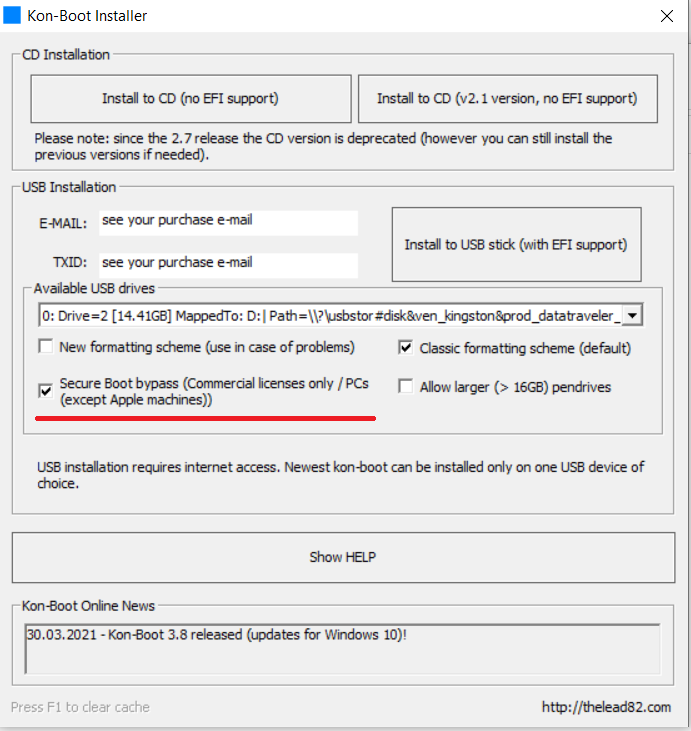
- Boot your target computer with Kon-Boot pendrive
-
Follow the steps explained on the images below:

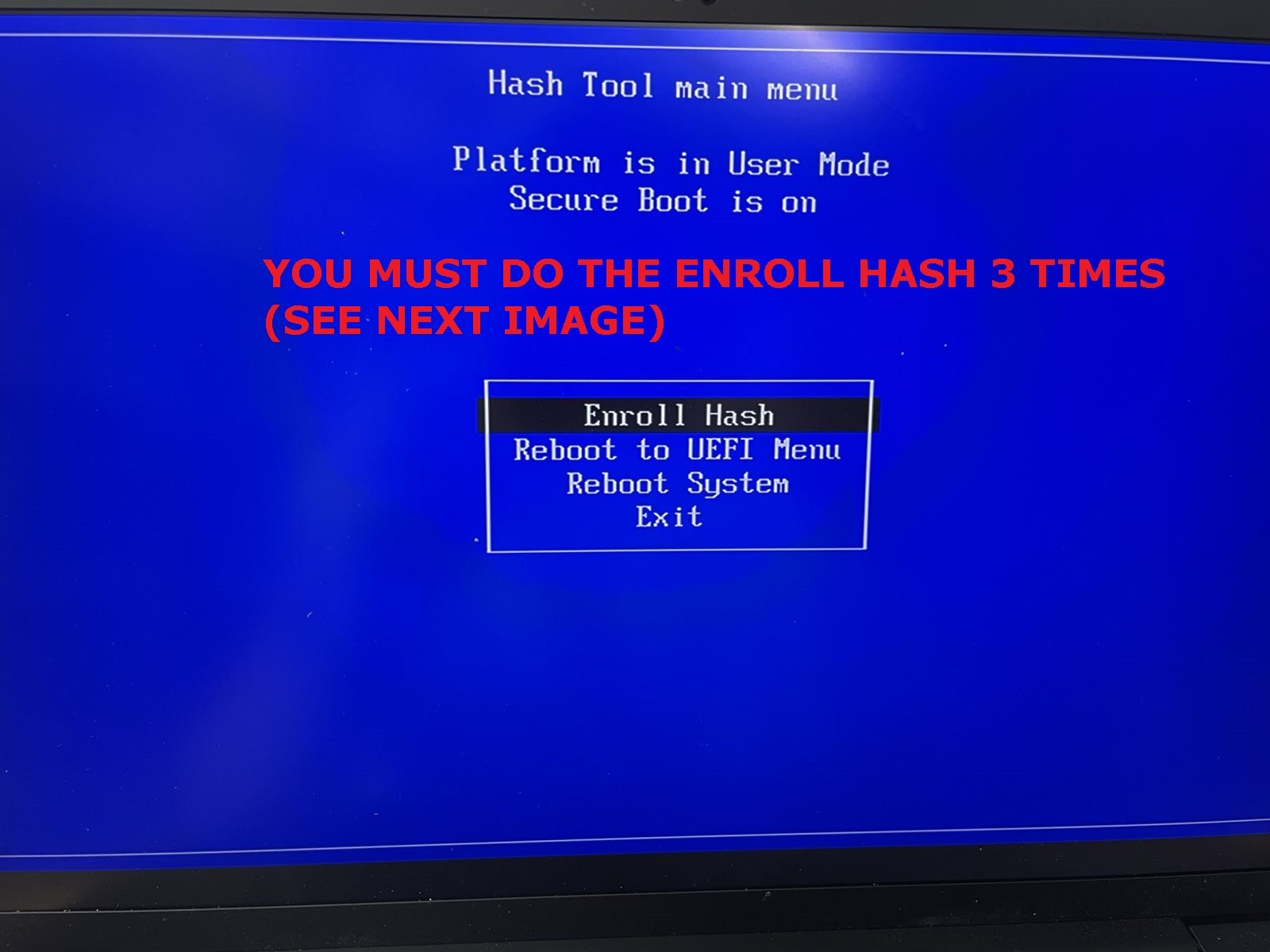
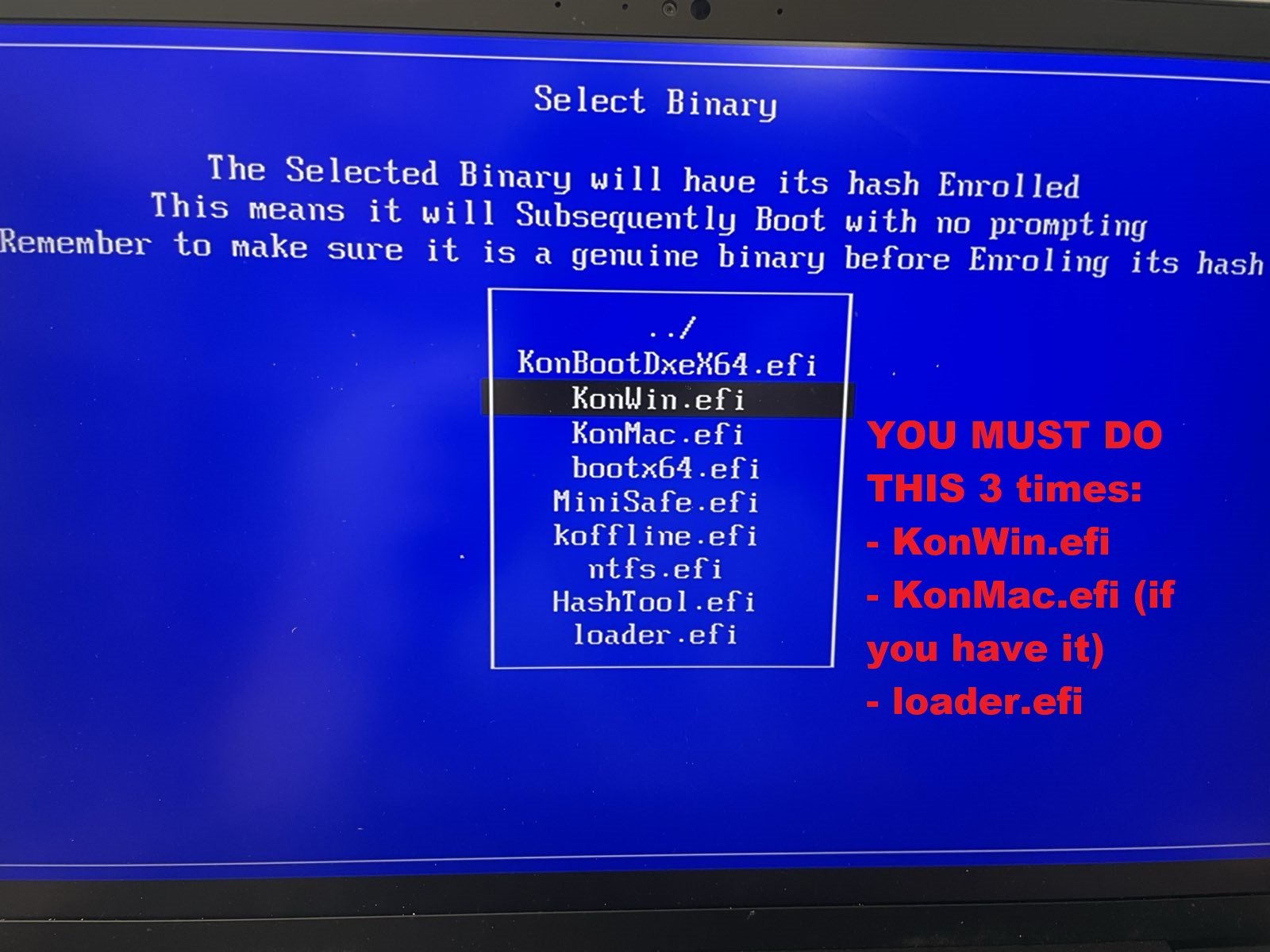
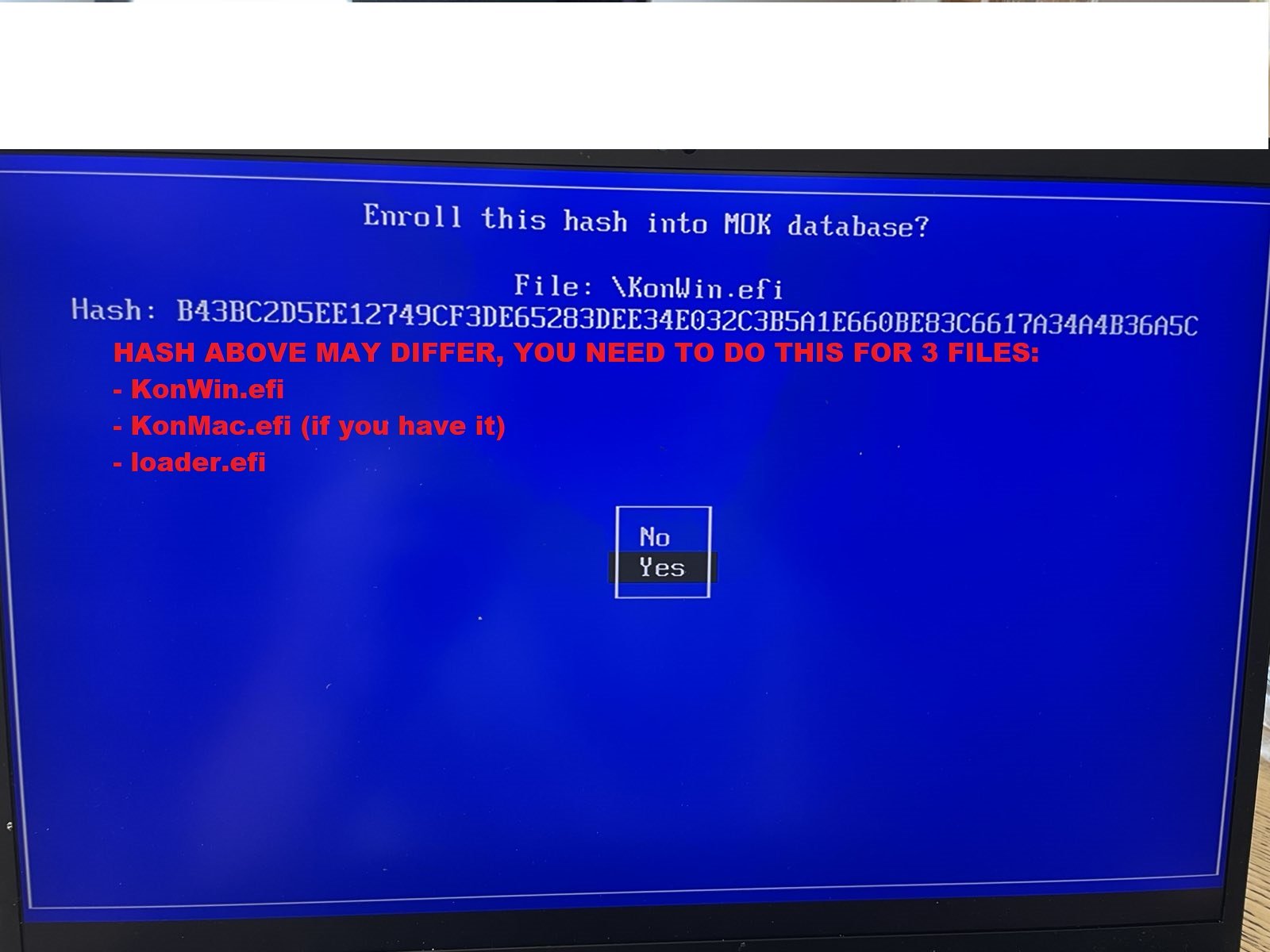
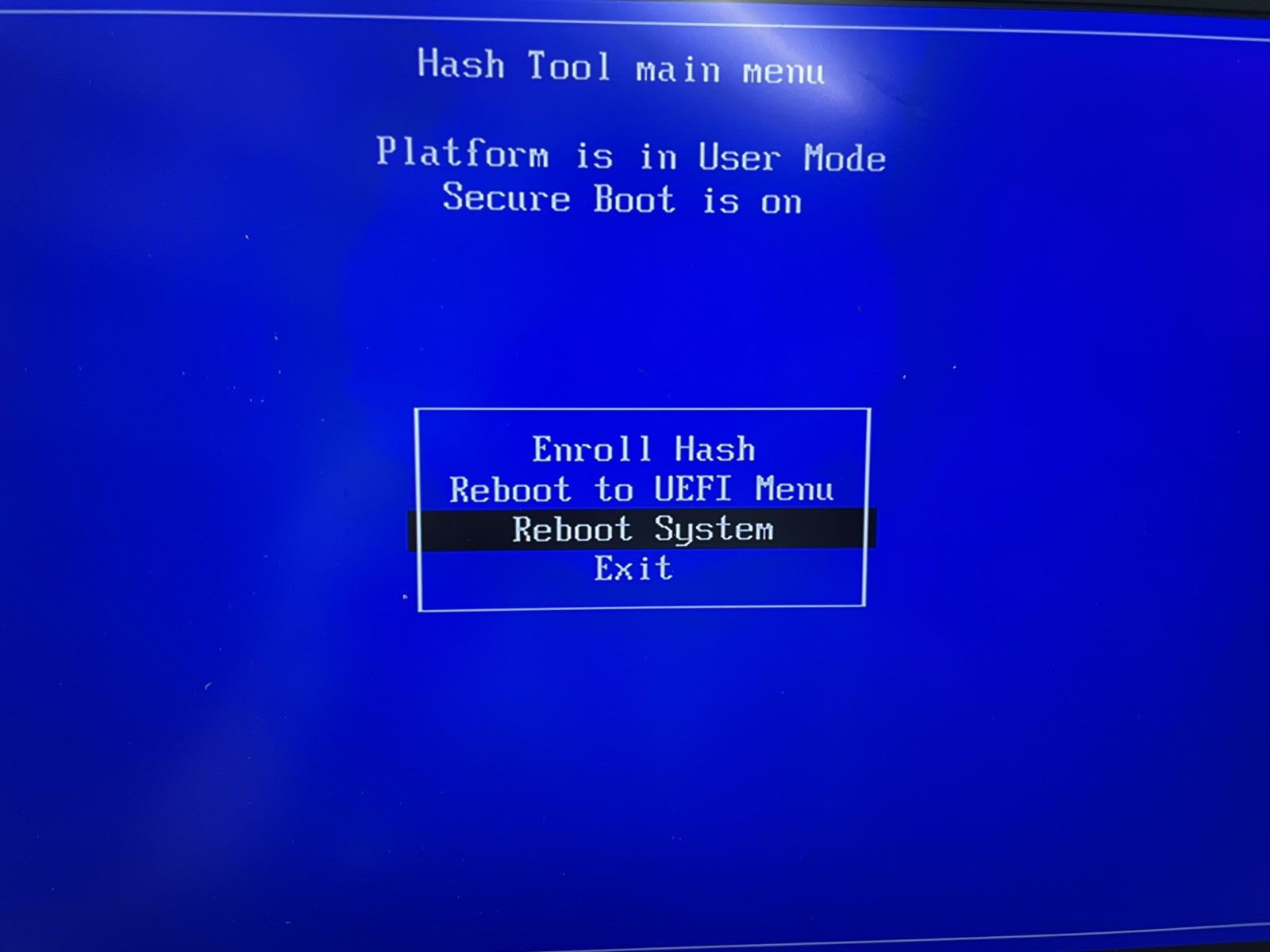
-
Reboot, Kon-Boot should be loaded automatically
Below is the procedure for the PREVIOUS depracated SecureBoot bypass:
- Prepare your Kon-Boot USB pendrive with Secure Boot Bypass option enabled

- Boot your target computer with Kon-Boot pendrive
- Enroll selected key as presented on the image below:

- Reboot, Kon-Boot should be loaded automatically
UEFI and Secure Boot feature
Starting from 3.5 version (commercial licenses) Kon-Boot is able to bypass Secure Boot protection on PCs (excluding Apple computers, limitations apply - depending on the UEFI firmware updates). See Secure Boot Bypass for details.
In order to use Kon-Boot in UEFI mode you need to make sure that the UEFI BIOS is not configured to use Secure Boot feature. Secure Boot feature is typically disabled however in case of any problems please enter the BIOS setup and disable the Secure Boot option manually (see examples below).
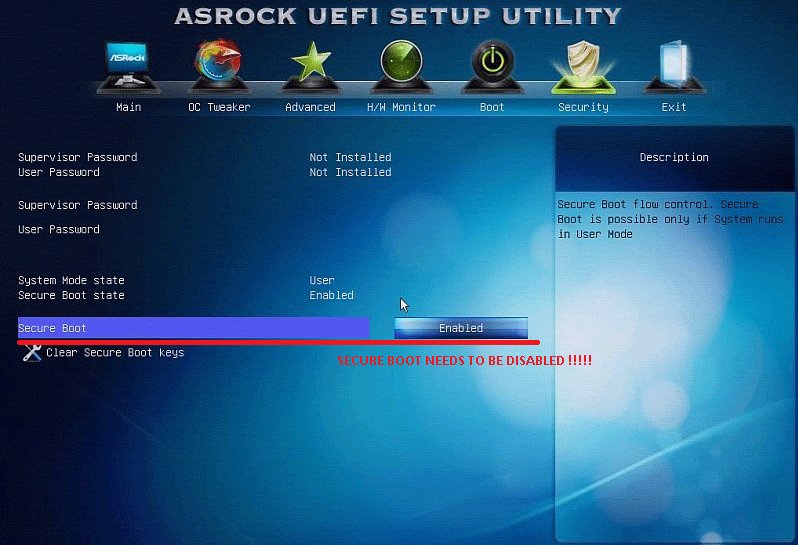 Above: UEFI Secure Boot option on ASRock motherboard
Above: UEFI Secure Boot option on ASRock motherboard

Above: UEFI Secure Boot option on Samsung motherboard
Disabling Secure Boot feature on Lenovo:
- Set Secure Boot option to disabled
- In the "Restart" tab, select "Disabled" for "OS Optimized Defaults" option and accept potential warnings
- In the "Restart" tab select "Load Setup Defaults" option and accept the displayed warnings
- Exit and save changes
Alternative approach:
- Set Secure Boot option to disabled
- Set the "OS Optimized Defaults" to "Other OS"
- Use the "Reset to setup mode" option in one of the BIOS tabs
- Exit and save changes
If you still have problems check out other youtube videos tutorials on this topic.
Disable virtualization support in BIOS (INTEL VT)
Newer Windows version use Virtualization-based Security (VBS) and/or hypervisor security. This can cause BSODs (Blue Screen Of Death) during loading Windows with Kon-Boot (Kon-Boot does not support virtualization). In order to prevent this from happening go to your BIOS setup and temporarily disable virtualization support (VT/VT-x) as presented on screenshots below.
This step is optional, try it if you experience Blue Screen of Death during booting your target Windows machine with Kon-Boot.
Following screenshots present how to disable virtualization support on various BIOSES (don't forget to SAVE the changed settings).
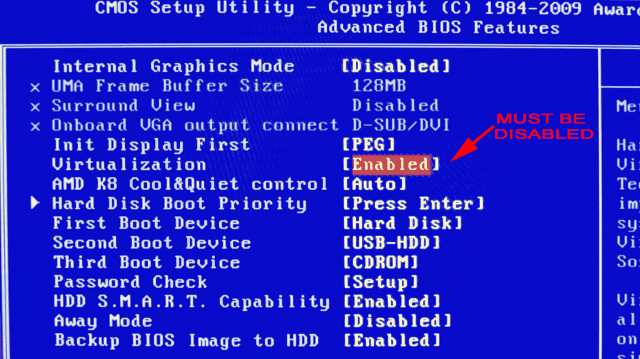

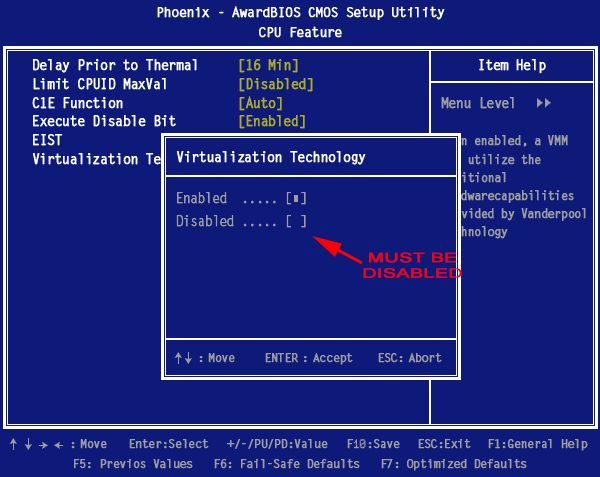
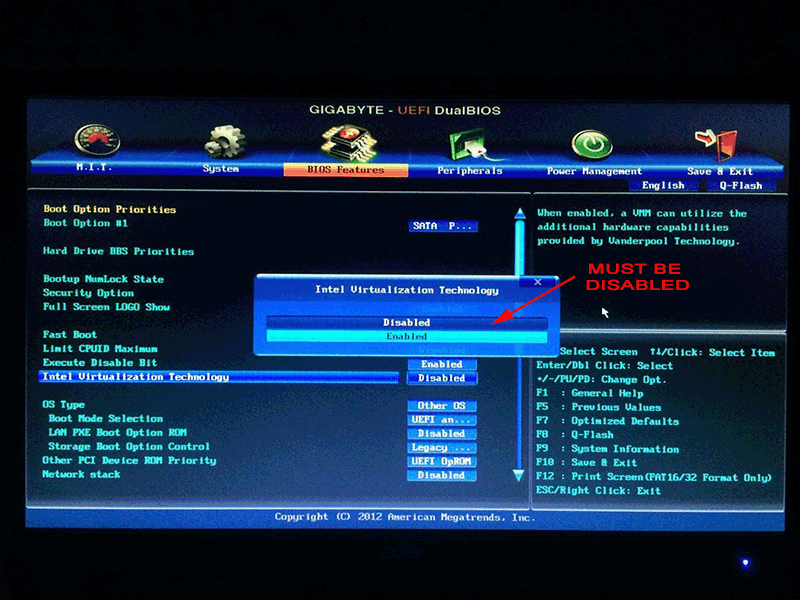
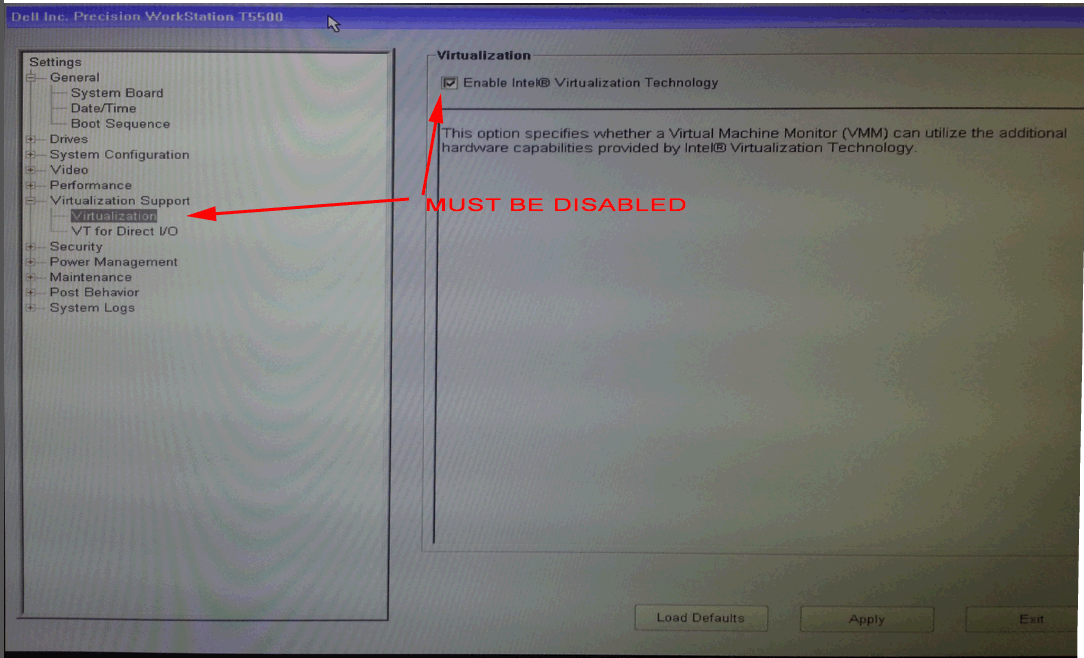
Disable virtualization AMD SVM (AMD Secure Virtual Machine Mode)
- Enter your BIOS SETUP (typically press F2 or DEL key during computer boot).
- Locate following option (AMD SVM, typically under Advanced Tab) and turn it to disabled.
- Exit and save changes!
In case of Gigabyte motherboard and AMD CPU:
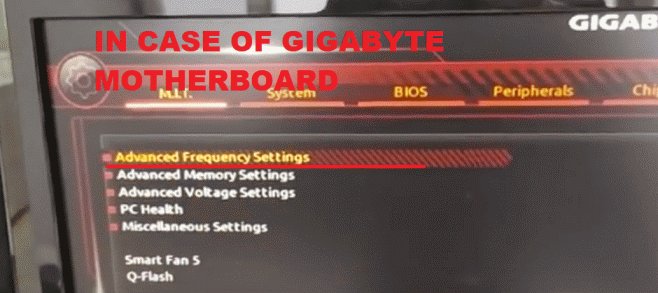


In case of Asus motherboard and AMD CPU:
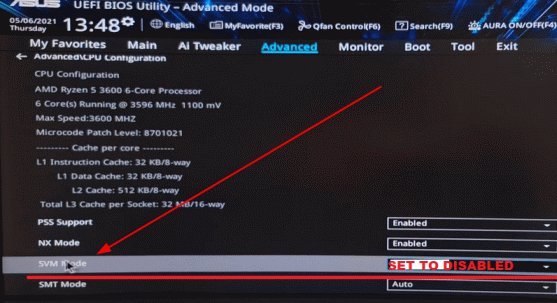
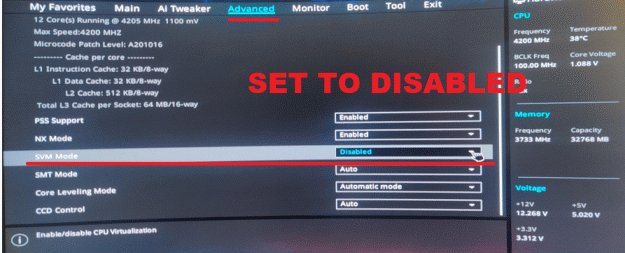
REMEMBER TO SAVE THE CHANGES (PRESS F10) BEFORE EXITING.
Automatic Powershell Script Execution Feature
Starting from version 2.7 (commercial edition only) kon-boot allows user to run automatic powershell script just after the boot of target operating system. Powershell script of user choice is being run with full system rights. This gives excellent and very powerful opportunity for the forensics team to gather all the necessary data from the target system. Right now the feature works only in UEFI mode and on Windows 8 / Windows 10 systems (x64).
Following video presents this feature at work:
In order to use this feature just edit the "auto.ps1" file on your kon-boot USB media.
Will this feature be added to normal (legacy) BIOS mode?
It seems rather unlikely. Legacy BIOS Kon-Boot loader is very hard to maintain, additional unscheduled constant Windows 8 / Windows 10 security updates do not make things easier. Finally UEFI is now recognized as the BIOS replacement. Check our faq for more detailed answer on this topic.
Sticky Keys Feature
What's Sticky Keys Feature? Sticky keys is a new Kon-Boot escalation feature which allows user to spawn a console window with system admin rights before the user is logged in. Kon-Boot allows you to get console window while the Windows login screen is still active.
Requirements:
- Windows operating system booted with kon-boot
- Sticky keys must be enabled in your target Windows system (they are by default)
- Kon-bootV2.1 and higher
Usage steps:
- In order to activate sticky keys feature please tap SHIFT 5 times (FAST). (it should work with default Windows configurations)
Video tutorial available below:
Following commands should be typed manually in the console:
net user /add [username] [password]
net localgroup administrators [username] /add
How to change profile password?
Please note: this is only for local accounts:
To change your password you can try the following way (after booting with kon-boot):
- Navigate the Start Menu to Control Panel
- Select "User Accounts and Family Safety"
- If the User Account Control window appears click "Yes" and leave the password field empty
- Select "Create a new account"
- Create the account (pick a name) and set the permissions (administrator).
- Disconnect Kon Boot and restart the computer to restore original Windows authentication functionality.
After restart:
- Select your new User Account (the account you have created)
- Navigate the Start Menu to Control Panel
- Select "User Accounts and Family Safety"
- Select the target User Account (the one you want to change)
- Select "Change the password"
- Input the new information for the account and click "Change password"
- You are done
How to change profile password using console?
You can change your local account password by using the Sticky Keys Feature and using following commands:
net user username newpassword
where the username is the name of the local account and newpassword is the new password for this local account. Please note this is only for local accounts.
How to remove kon-boot account on Windows
You can delete your local Windows account by using the Sticky Keys Feature and using following commands:
net user username /delete
where the username is the name of the local account.
So in case of kon-boot account, type:
net user kon-boot /delete
and press enter.
Password expired
If you experience "password has expired and needs to be changed" error during your login attempt it simply means that your password has expired. This is caused by custom Windows password policy not a problem of Kon-Boot itself.
To fix this issue (after booting the target Windows OS with Kon-Boot):
- Use the Sticky Keys Feature to activate the administrator console
- Type:
net user username /expires:never(where username is the target user name) - If previous step was not enough, try typing:
net user username newpassword(where username is the target user name) - Reboot for changes to take effect
Locked account (account unlock)
It should be possible to unlock a locked Windows account by using the Sticky Keys Feature:
- Use the Sticky Keys Feature to activate the administrator console
- Type:
net user username /active=yes(where username is the target user name) - Reboot for changes to take effect
If this is a domain account please try:
- Use the Sticky Keys Feature to activate the administrator console
- Type:
net user username /DOMAIN /active:YES(where username is the target user name) - Reboot for changes to take effect
Please note Kon-Boot is a tool for bypassing passwords not really designed for unlocking so this information is just "extra".
Windows 10 Online Authorization Support
UPDATE 05.2018: Windows 10 online account authorization bypass was added to the 2.8 Kon-Boot Release (commercial licenses only, UEFI systems only).
Following video completely illustrates this entire process:
As for personal licenses:
Personal licenses does not offer online authorization bypass on Windows 10 systems. However user can still access the system as local administrator. In fact in the kon-boot v2.5 administrator account can be added automatically, as presented in the following scenario:
- Boot your machine with kon-boot on USB (usb version is required)
- Wait until your Windows 10 machine boots up
- You should see following message displayed on the screen
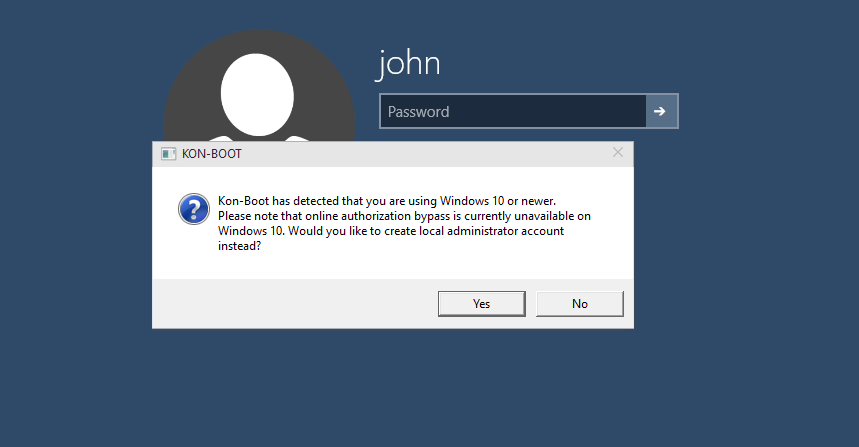
- If you want to get your new administrator account added click YES and follow the rest of instructions displayed on the screen
In case of problems (i.e. when message box was not displayed) you can add the administrator account manually using the sticky keys feature. Please see the Sticky Keys Feature for further details.
Windows HELLO login
If you account is an online (live) Windows 10 account and you have a commercial Kon-Boot license (commercial kon-boot licenses allow to bypass Windows 10 online/live passwords (UEFI)) you can bypass the Windows HELLO authorization as well.

Please notice: for online/live password bypass option to work it is necessary to wait approximetely ~5minutes after Windows login screen appears (Kon-Boot message box should be displayed on the screen when things are ready).
- After selecting your target account, please pick Sign-in options
- Pick Microsoft account password option (or PIN alternatively)
- Put any password / pin (not blank) and press enter
BitLocker Recovery Screen
As stated multiple times on our website and here as well Kon-Boot does not support enabled disk encryption (BitLocker is disk encryption software). If you see screen similar to this below it means your hard drive is encrypted.
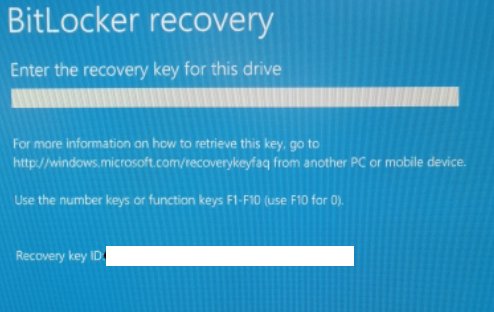
Please note: You may only see this screen when you are booting from external media ie. Kon-Boot USB. This is because of the TPM chip (Trusted Platform Module) which will detect changes to the system boot sequence. This will lead to change in the TPM's PCR values, and in the result TPM will not unseal the VMK (Volume Master Key).
Running on Virtual Machines
Kon-Boot generally does not support running in virtualized environments ie. inside virtual machines. However there are some exceptions to this rule. If the target system was installed in LEGACY MODE (not UEFI) then it may be possible to use kon-boot (with some limitations).
If you have a Windows operating system installed in legacy mode inside Virtual Machine you can try following way:
- attach a floppy drive to the virtual machine and use kon-boot image from your package ie. C:\kon-boot\kon-bootUSB\USBFILES\konbootPLUS.img or C:\kon-boot\kon-bootUSB\USBFILES\konbootPLUS_ALT.img (assumming C:\kon-boot was your installation path)
- power on the virtual machine
- go to BIOS SETUP (F2) and set the first boot option to FLOPPY, save and exit (F10)
- boot with kon-boot
- if your Windows loads correctly put any password and press enter (if it's local password it should be bypassed) or use the Sticky Keys Feature
Please note: we don't provide support for Virtual Machines. Online/live password bypass is not available in LEGACY MODE.
Trouble creating USB / Trouble installing to USB
-
Have you installed / extracted kon-boot package to c:\kon-boot ? if not please do so (do not install to external drives or remote locations)
-
Please verify you have administrator access on the Windows installation machine, the lock error may be caused by either lack of administrator rights or different process (like antivirus) blocking access to usb device.
-
Please make sure your Internet connection is working.
-
If problem persists please try different USB port or different USB thumb drive (KINGSTON, TOSHIBA etc.). Recently we stopped recommending SANDISK ULTRA.
If problem still persists please contact support and attach the konlog.txt file from Kon-Boot installation directory.
Support
Please visit the Contact us / Support page for details.